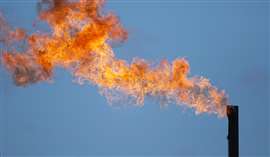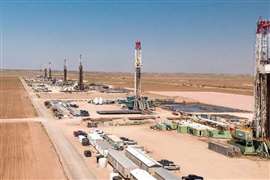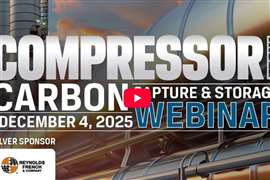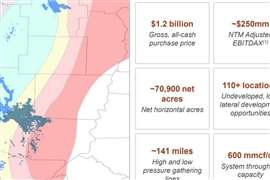Read this article in 中文 Français Deutsch Italiano Português Español
EPA releases final methane emissions rules
December 04, 2023
Requires comprehensive monitoring of wells, compressor stations
The U.S. Environmental Protection Agency (EPA) announced a final rule designed to sharply reduce methane and other emissions from the oil and natural gas industry.
The final rule was announced by Administrator Michael S. Regan and President Biden’s National Climate Advisor Ali Zaidi at COP28 in Dubai, United Arab Emirates (UAE).
The EPA estimates the new rule will reduce methane emissions nearly 80% below what they were projected to be, and that will “prevent an estimated 58 million tons of methane emissions from 2024 to 2038.”
Among other things, the final rule will:
- phase in a requirement to eliminate routine flaring of natural gas that is produced by new oil wells;
- require comprehensive monitoring for leaks of methane from well sites and compressor stations; and
- establish standards that require reductions in emissions from high-emitting equipment like controllers, pumps, and storage tanks.
In addition, the final rule includes a Super Emitter Program that will utilize third-parties in remote sensing to detect large methane releases or leaks known as “super emitters.”
The rule also clarifies how states can use their existing programs in plans for limiting methane emissions from existing sources and gives states two years to submit their plans for EPA approval.
The rule would achieve a nearly 80 percent reduction below the future methane emissions expected without the rule. These reductions are greater than what was projected for the 2022 and 2021 proposals, thanks to changes that strengthen provisions to limit wasteful, polluting flaring of natural gas and analytical updates that better capture the impacts of this rulemaking.
“As the world gathers to tackle the climate crisis, the U.S. now has the most protective methane pollution limits on the books. EPA’s limits on oil and gas methane pollution are a vital win for the climate and public health, dramatically reducing warming pollution and providing vital clean air protections to millions of Americans. With other countries also zeroing in on methane as a key climate risk, it’s a signal to operators worldwide that clean-up time is here,” said Fred Krupp, President of the Environmental Defense Fund. “EPA has shown tremendous leadership in establishing these leading clean air standards and we look forward to working with states and EPA to move quickly on implementation. The communities who fought long and hard for these protections now need to begin to reap their benefits.”
“bp welcomes the finalization of a federal methane rule for new, modified and - for the first time - existing sources,” said Orlando Alvarez, Chairman and President, bp America. “A well-designed rule will help drive material methane emission reductions this decade and beyond. We appreciate the collaborative way EPA, NGOs and industry worked together on this rulemaking. In the spirit of COP28, input from a broad range of stakeholders makes for more durable and effective policies. We congratulate the Administration on this important milestone and look forward to working together on the next phases of implementation.”
 The U.S. Environmental Protection Agency (EPA) announced a final rule designed to sharply reduce methane and other emissions from the oil and natural gas industry. (Image: NASA)
The U.S. Environmental Protection Agency (EPA) announced a final rule designed to sharply reduce methane and other emissions from the oil and natural gas industry. (Image: NASA)
Building on two proposed rules issued in November 2021 and December 2022, the final requirements also incorporate feedback and information that EPA received through nearly 1 million public comments, as well as extensive engagement with a broad range of stakeholders.
The EPA will hold trainings in early 2024 to provide an overview of the final rule for communities, Tribes, tribal environmental professionals and small businesses. Information on trainings will be posted as they are scheduled.
Dry seal compressor changes
Several comments were offered about regulating dry seal compressors. Here is the EPA’s response from the final rule:
The EPA has evaluated these comments and acknowledges that the data available on dry seal compressor emissions and flow rates was limited and that a 3 scfm volumetric flow rate performance standard may not be achievable for some centrifugal compressors equipped with dry seals, even when properly maintained and the dry seal is not in need of repair.
Prior to receipt of these comments and based on available information and data, it was believed that these higher-emitting dry seal compressors represented compressors in need of repair or maintenance.
In fact, the EPA had not previously regulated centrifugal compressors equipped with dry seals because they were considered low-emitting when compared with compressors equipped with wet seals.
What has become evident, however, is that some centrifugal compressors equipped with dry seals emit more than previously believed and that a properly functioning compressor equipped with a dry seal can be higher-emitting than a centrifugal compressor equipped with a wet seal that is subject to requirements under NSPS OOOOb. Given that compressors equipped with wet seals are regulated under NSPS OOOO, NSPS OOOOa, and the final NSPS OOOOb, and given that compressors equipped with dry seals are known to emit more than some compressors with wet seals, the final rule retains the requirement to conduct volumetric flow rate monitoring and associated maintenance and repair (as needed) of these compressors consistent with what is required for centrifugal compressors equipped with wet seals.
However, the EPA has revised the proposed volumetric flow rate performance standard for centrifugal compressors with dry seals to be 10 scfm/seal (i.e., representing a maximum flow rate applicable to all dry seals). Based on manufacturer data provided on dry seal rate curves for differing compressor models and configurations, a 10 scfm per seal flow rate performance standard is supported as a maximum flow rate performance standard that could be applicable to all dry seals until additional flow rate and emissions data are obtained under GHGRP subpart W. The 10 scfm per seal flow rate performance limit reflects ordinary performance of a well maintained unit, therefore minimal additional costs are expected. In many instances, compressors equipped with dry seals will already be required to conduct annual compressor vent volumetric flow rate monitoring under GHGRP subpart W. Owners or operators of these compressors will be subject to minor recordkeeping and reporting requirements, and maintenance and repair requirements would only apply where the volumetric flow rate performance standard of 10 scfm per seal is exceeded.
For owners or operators not already required to conduct annual compressor vent volumetric flow rate monitoring under GHGRP subpart W, the only additional cost is the cost of conducting the required volumetric flow rate monitoring.
CONNECT WITH THE TEAM









